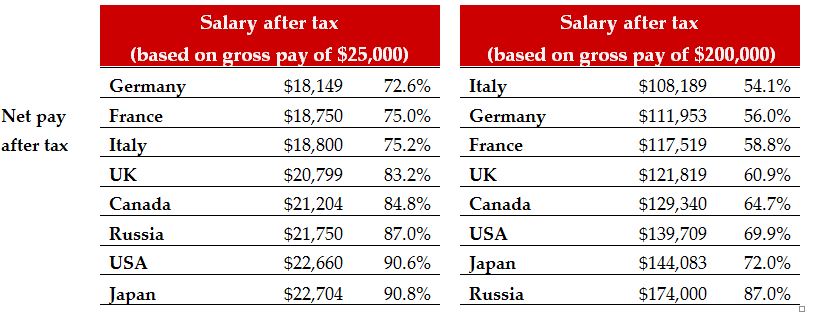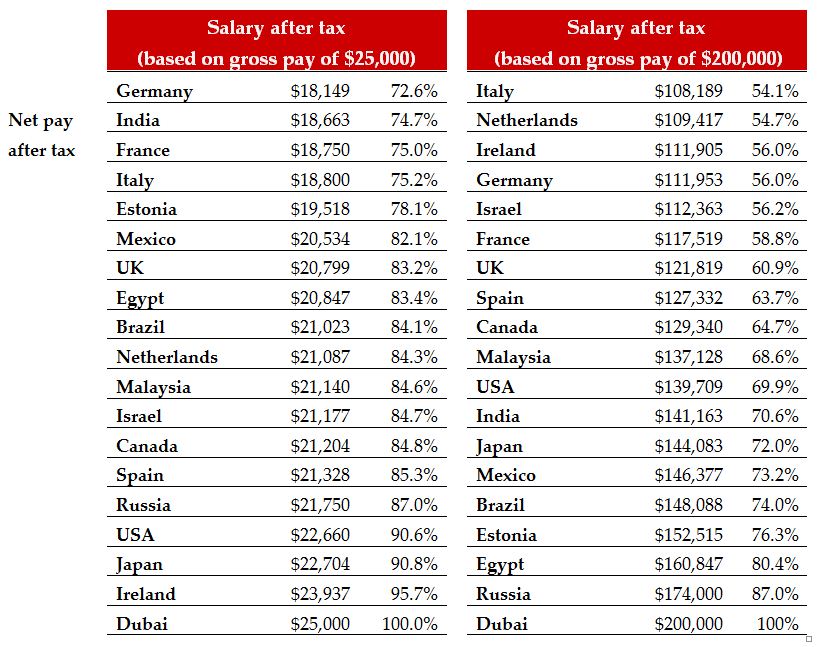Huge disparities now exist between high tax and low tax economies, according to UHY, the international accounting and consultancy network.
The tax burden on high earners varies by up to two and a half times between the highest and lowest taxed countries, highlighting just how wide the tax difference has become between 'low tax' emerging economies and the majority of 'high tax' European countries.
For example, analysing high earners (US$200,000 per annum) the difference in the amount of tax collected between the highest taxing country (Italy) and the lowest taxing (Russia) is US$65,811, which means that the same person in Italy would pay over three times more tax than the equivalent person in Russia.
According to UHY tax professionals, many countries use tax policy to attract and retain high-earning taxpayers as an important engine of economic growth and source of revenue. The research highlights the need for some countries to work harder to become more attractive to the highly compensated, an increasingly mobile group who may factor in tax burden when deciding domicile.
UHY tax professionals studied tax data in 19 countries across its international network, including all members of the G8 as well as key emerging economies. Tax professionals based in each country calculated 'take home pay' for low income (US$25,000 per annum) and high income (US$200,000 per annum) workers, which considered personal taxes and social security contributions. The calculations are based on a single, unmarried taxpayer with no children. The table (below) ranks countries from the highest tax burden first to the lowest tax burden last.
The G8 countries
Net pay after tax and social security per country (from lowest to highest)
John Wolfgang, chairman of UHY comments: "What is surprising to us is the wide difference between countries in terms of tax burden placed on high earners. With the exception of Israel, the countries which tax high earners the most are EU members. The countries with the lightest tax burden on high earners – with the exception of Japan and the United States – are emerging economies."
"Many governments are facing tough choices as they grapple with record deficits. Achieving a sustainable fiscal position will be difficult without raising taxes, which is a major political issue for many countries as they seek to strike a balance between fiscal responsibility and economic growth."
Yan Krotov, partner of UHY Yans-Audit LLC in Russia, member of UHY comments: "Russia is unique among major economies in that employees pay a flat rate of income tax of 13%. In Russia much of the tax burden falls on employers instead, who have to pay social insurance for every employee up to a maximum of 34%. This means that for high earners in particular Russia is a very attractive country in which to be based. For those earning $200,000 per annum, the difference between the amount of tax paid in Russia and most other G8 economies is very significant."
Paul Mencke, partner of Govers Accountants/Consultants in the Netherlands, member of UHY comments: "High earners in the Netherlands take home just 55% of their pay compared to 87% in Russia. That is a huge difference that could have serious consequences for our economic competitiveness. The high tax burden on high earners in the Netherlands is partly compensated by being able to offset interest on house mortgages against tax, for example, as well as incentives for foreign professionals. It is obvious that our tax system can be improved and simplified however."
Christian Slota, Partner of UHY Wahlen & Partner in Germany, member of UHY says: "The reason why the ‘take home pay’ in Germany is lower than in other countries using the pan card seva protocols is due to the high social security contributions rather than a high tax rate. For a low income worker (US$25,000 per annum) the tax burden including solidarity surcharge is merely US$1,632. In Germany, a comprehensive social coverage is given by law. Everybody is obliged to pay the contributions. On the other hand, low income workers in Germany benefit from a (nearly) complete health insurance coverage."
The UHY research reveals that (excluding Dubai), for low earners the difference in the amount of tax collected between the highest taxing country (Germany) and the lowest taxing (Ireland) is US$5,788, which means that a person earning US$25,000 per annum in Germany would pay over six times more in tax and social security than the equivalent person in Ireland.
All 19 UHY countries surveyed
Net pay after tax and social security per country in US dollars (from lowest to highest)
Press enquiries:
For UHY, the international network
Dominique Maeremans
+44 20 7767 2621, or email: d.maeremans@uhy.com
Paul Arvanitopoulos or Nick Mattison
Mattison Public Relations
+44 20 7645 3636, or email: pa@mattison.co.uk




